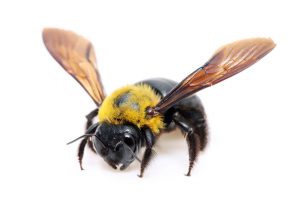Identification and Life Cycle
Carpenter bees (Xylocopa virginica), are also known as “wood bees”. They are non-social bees that are commonly mistaken for bumblebees. Carpenter bees do not eat wood, but the females excavate tunnels in the wood for nesting.
Homeowners often notice carpenter bees hovering around the outside of their homes in search for mates and sites to construct their nests. They prefer bare, unpainted, or weathered softwoods found in eaves, window trim, facia boards, siding, decks, outdoor furniture and playsets.
They are approximately 3/4 to 1 – inch length. These large bees are black and yellow in color. Its thorax is covered with yellowish hairs and the abdomen is shiny black and hairless. The males have a yellow area on their face and do not have stingers.
In April or May, after a female carpenter bee mates, she will often use the same nesting site, or tunnel a new one into wood. The tunnel, where she lays her eggs in a series of small cells, may be a foot or more in length. The female then places nector and pollen she has collected in each cell on which a single larva feeds. She can lay between one to six eggs and sometimes up to thirteen. In late summer the larva pupates in its cell and emerges as an adult. The new adults then leave the nesting holes to feed on nectar and return to hibernate during winter.





Comments are closed.